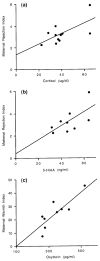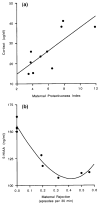Mother-infant interactions in free-ranging rhesus macaques: relationships between physiological and behavioral variables
- PMID: 19150451
- PMCID: PMC3955190
- DOI: 10.1016/j.physbeh.2008.12.016
Mother-infant interactions in free-ranging rhesus macaques: relationships between physiological and behavioral variables
Abstract
Studies of mother-infant relationships in nonhuman primates have increasingly attempted to understand the neuroendocrine bases of interindividual variation in mothering styles and the mechanisms through which early exposure to variable mothering styles affects infant behavioral development. In this study of free-ranging rhesus macaques on Cayo Santiago, Puerto Rico, we aimed to: 1) compare lactating and nonlactating females to investigate whether lactation is associated with changes in plasma cortisol, prolactin and oxytocin, as well as changes in CSF levels of serotonin and dopamine metabolites (5-HIAA and HVA); 2) examine the extent to which interindividual variation in maternal physiology is associated with variation in maternal behavior; 3) examine the extent to which interindividual variation in infant physiology and behavior is accounted for by variation in maternal physiology and behavior. Lactating females had higher plasma concentrations of cortisol, prolactin, and oxytocin but lower CSF concentrations of HVA than nonlactating females. Variation in maternal rejection behavior was positively correlated with variation in maternal plasma cortisol levels and in CSF 5-HIAA levels while variation in the time spent nursing and grooming was associated with maternal plasma oxytocin levels. Infants who were protected more by their mothers had higher cortisol levels than those who were protected less, while infants who were rejected more had lower CSF 5-HIAA than infants who were rejected less. Since exposure to high levels of maternal protectiveness and rejection is known to affect the offspring's behavior and responsiveness to the environment later in life, our results are consistent with the hypothesis that these effects are mediated by long-term changes in the activity of the offspring's HPA axis and brain serotonergic system.
Figures


References
-
- Hinde RA, Spencer-Booth Y. The study of mother–infant interaction in captive group-living rhesus monkeys. Proc R Soc Lond B. 1968;169:177–201.
-
- Hinde RA, Spencer-Booth Y. Towards understanding individual differences in rhesus mother–infant interaction. Anim Behav. 1971;19:165–73.
-
- Altmann J. Baboons mothers and infants. Cambridge, MA: Harvard University Press; 1980.
-
- Berman CM. Variation in mother–infant relationships: traditional and nontraditional factors. In: Small MF, editor. Female primates: studies by women primatologists. New York: Alan Liss; 1984. pp. 17–36.
-
- Fairbanks LA. Individual differences in maternal styles: causes and consequences for mothers and offspring. Adv Study Behav. 1996;25:579–611.
Publication types
MeSH terms
Substances
Grants and funding
LinkOut - more resources
Full Text Sources

